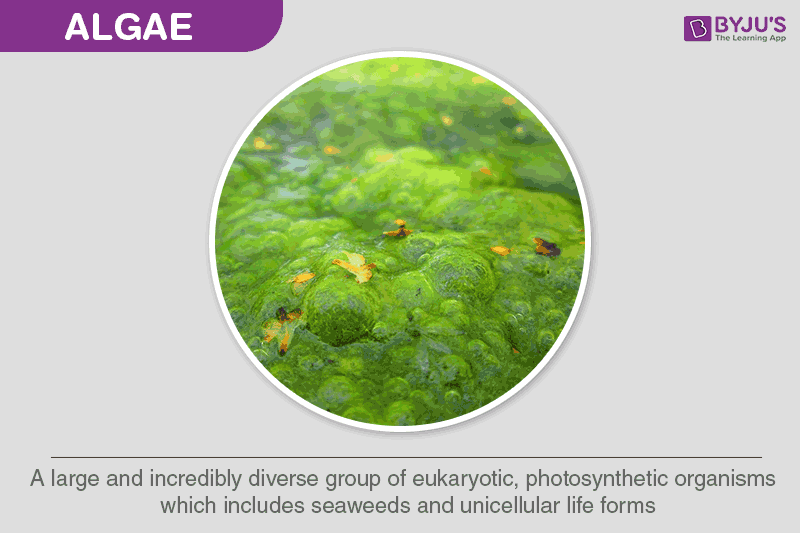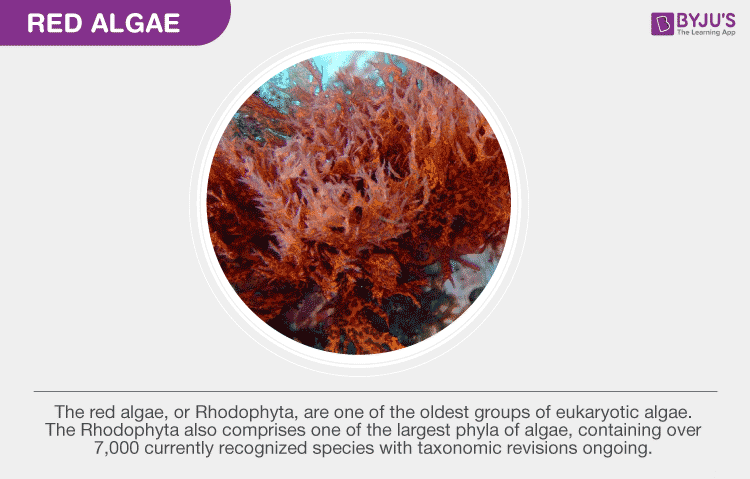Table of Contents
- What are Algae?
- Algae Definition
- Characteristics of Algae
- Types of Algae
- Not an Algae: Blue-Green Algae
- Examples of Algae
- Algal Biofuel
What are Algae?
Algae exist in environments ranging from oceans, rivers, and lakes to ponds, brackish waters and even snow. Algae are usually green, but they can be found in a variety of different colours. For instance, algae living in snow contain carotenoid pigments in addition to chlorophyll, hence giving the surrounding snow a distinctive red hue.
Read on to explore more about the types and characteristics of algal cells in the notes provided below.

Algae Definition
“Alga is a term that describes a large and incredibly diverse group of eukaryotic, photosynthetic lifeforms. These organisms do not share a common ancestor and hence, are not related to each other (polyphyletic).”
Multicellular examples of algae include the giant kelp and brown algae. Unicellular examples include diatoms, Euglenophyta and Dinoflagellates.
Most algae require a moist or watery environment; hence, they are ubiquitous near or inside water bodies. Anatomically, they are similar to another major group of photosynthetic organisms – the land plants. However, that is where the differences end as algae lack many structural components typically present in plants, such as true stems, shoots, and leaves. Furthermore, they also do not have vascular tissues to circulate essential nutrients and water throughout their body.
Characteristics of Algae
Specific general characteristics of algae are common to plants as well as animals.
Algal cells are eukaryotic. For instance, algae can photosynthesize like plants, and they possess specialized structures and cell-organelles, like centrioles and flagella, found only in animals. The algal cell walls consist of mannans, cellulose and Galatians. Listed below are some of the general characteristics of algae.
- Algae are photosynthetic organisms
- Algae can be either unicellular or multicellular organisms
- Algae lack a well-defined body, so, structures like roots, stems or leaves are absent
- Algaes are found where there is adequate moisture.
- Reproduction in algae occurs in both asexual and sexual forms. Asexual reproduction occurs by spore formation.
- Algae are free-living, although some can form a symbiotic relationship with other organisms.
Types of Algae
There are many types of algae. However, these are some of the more prominent types:
Red Algae
Also called Rhodophyta, it is a distinctive species found in marine as well as freshwater ecosystems. The pigments phycocyanin and phycoerythrin are responsible for the characteristic red colouration of the algae. Other pigments that provide green colouration (such as chlorophyll a) are present. However, they lack chlorophyll b or beta-carotene.
Extended Reading: Red Algae

Green Algae
It is a large, informal grouping of algae having the primary photosynthetic pigments chlorophyll a and b, along with auxiliary pigments such as xanthophylls and beta carotene.
Higher organisms use green algae to conduct photosynthesis for them. Other species of green algae have a symbiotic relationship with other organisms.
Members are unicellular, multicellular, colonial and flagellates. Prominent examples of green algae include Spirogyra, Ulothrix, Volvox, etc.
Extended Reading: Chloroplasts
Not an Algae: Blue-Green Algae
In the past, blue-green algae were one of the most well-known types of algae. However, since blue-green algae are prokaryotes, they are not currently included under algae (because all algae are classified as eukaryotic organisms).
Also called cyanobacteria, these organisms live in moist or aquatic environments just like other algae. These include dams, rivers, reservoirs, creeks, lakes and oceans. This class of bacteria obtains energy through the process of photosynthesis. Ecologically, some species of blue-green algae are significant to the environment as it fixes the nitrogen in the soil. Hence, these are also called nitrogen-fixing bacteria. E.g. Nostoc, Anabaena, etc.
Also Read: Rhizobium – The Nitrogen Fixing Bacteria
However, other types of blue-green algae can be toxic to human beings. They can either be neurotoxic (affects the respiratory or nervous system, causing paralysis) or hepatotoxic (causes the liver to fail). Moreover, some can act as indicators of environmental health, signalling the extent of pollution.
Examples of Algae
Prominent examples of algae include:
- Ulothrix
- Fucus
- Porphyra
- Spirogyra
Algal Biofuel
Recent developments in science and technology have enabled algae to be used as a source of fuel. Global demand for petroleum products and declining environmental health have prompted the use of eco-friendly alternatives such as algal biofuel. Hence, algae fuel is an increasingly viable alternative to traditional fossil fuels. It is used to produce everything from “green” diesel to “green” jet fuel. It is similar to the other biofuels made from corn and sugar cane.
For more information about algae, its types and characteristics of algae, or any other concepts in biology, explore BYJU’S Biology.
Further Reading:
- Lichens
- Thallophyte
- Difference Between Algae And Fungi
- Vaucheria: Classification, structure and Life cycle
- Chlamydomonas: Classification, Structure and Life Cycle
Frequently Asked Questions
1. What are Algae?
2. How are algae different from traditional plants?
3. Briefly outline the types of algae.
Algae are primarily classified into the following types:
- Blue-green Algae
- Red Algae
- Green Algae
4. State the general characteristics of algae.
- Algae are either unicellular or multicellular in nature
- Found in moist places
- Mode of reproduction can be sexual as well as asexual
- Asexual reproduction occurs by spore formation
- Sexual reproduction occurs by the physical contact of haploid gametes
- Lacks a well-defined body
- They are photosynthetic in nature
- Are mostly free-living
5. State 4 examples of algae.
- Volvox
- Spirogyra
- Ulothrix
- Fucus
6. Are algae bacteria or a plant?
Algae are neither bacteria nor plants. The term algae is used to describe a large collection of photosynthetic, eukaryotic organisms.
7. Are algae toxic to humans?
Algae are generally harmless to humans. However, certain species of algae can form algal blooms, which can have detrimental effects on human health and the environment.
8. How are algae useful?
Algae are known to fix 50% carbon dioxide. Being photosynthetic, they increase the oxygen content of their environment. They are primary producers and many organisms derive food from them. Many commercial products are obtained from algae such as align, etc.
9. Why are algae important?
Algae form the primary source of food for many organisms in the food chain. From an economical perspective, algae are very useful for creating biomass or fertilizers as they grow very fast.
10. What are algal blooms?
Algal bloom is the rapid increase in the algal population in a water body such as rivers or lakes. Often, it is characterized by discolouration of the water and a peculiar odour.
Register at BYJU’S for easy and interesting algae notes. Refer to these notes for reference.

It is very useful to check the answers following question we type. we get answer and its details completely.
I need some material work on bsc 1st year for botany
But this app is really helpful and provides whole information from top to bottom and also provides short questions which is very important to a child attending lecture
So its a important as well as useful app
is algae alive
Yes, algae are living organisms and they also perform photosynthesis.
Algae disease of horticulture
Is Spirogyra multicellular or unicellular
The vegetative structure of Spirogyra is filamentous and multicellular. Each cylindrical cell is joined end to end forming an unbranched filamentous thallus. Learn more about spirogyra here: https://byjus.com/neet/spirogyra/